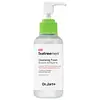What's inside
What's inside
 Key Ingredients
Key Ingredients

No key ingredients
 Benefits
Benefits

 Concerns
Concerns

 Ingredients Side-by-side
Ingredients Side-by-side

Melaleuca Alternifolia Leaf Extract
PerfumingWater
Skin ConditioningDisodium Laureth Sulfosuccinate
CleansingSodium Cocoyl Glutamate
CleansingMethylpropanediol
Solvent1,2-Hexanediol
Skin ConditioningAcrylates/C10-30 Alkyl Acrylate Crosspolymer
Emulsion StabilisingSalicylic Acid
MaskingMelaleuca Alternifolia Leaf Oil
AntioxidantCentella Asiatica Extract
CleansingFicus Carica Fruit Extract
HumectantPolyglyceryl-10 Laurate
Skin ConditioningAnthemis Nobilis Flower Extract
MaskingCamellia Sinensis Leaf Extract
AntimicrobialGlycyrrhiza Glabra Rhizome/Root
EmollientAmaranthus Caudatus Seed Extract
Skin ConditioningUlmus Davidiana Root Extract
Skin ConditioningHamamelis Virginiana Extract
AntiseborrhoeicUndaria Pinnatifida Extract
Skin ConditioningGloiopeltis Furcata Extract
Skin ConditioningAloe Barbadensis Leaf Extract
EmollientCinnamomum Zeylanicum Bark Extract
AntimicrobialPinus Pinaster Bark Extract
AntioxidantButylene Glycol
HumectantDisodium EDTA
Hydrogenated Lecithin
EmulsifyingCeramide NP
Skin ConditioningAllantoin
Skin ConditioningNiacinamide
SmoothingSilica
AbrasiveCapryloyl Glycine
CleansingHexylene Glycol
EmulsifyingCamphor
MaskingSarcosine
Skin Conditioning4-Terpineol
MaskingMethyl Methacrylate Crosspolymer
Melaleuca Alternifolia Leaf Extract, Water, Disodium Laureth Sulfosuccinate, Sodium Cocoyl Glutamate, Methylpropanediol, 1,2-Hexanediol, Acrylates/C10-30 Alkyl Acrylate Crosspolymer, Salicylic Acid, Melaleuca Alternifolia Leaf Oil, Centella Asiatica Extract, Ficus Carica Fruit Extract, Polyglyceryl-10 Laurate, Anthemis Nobilis Flower Extract, Camellia Sinensis Leaf Extract, Glycyrrhiza Glabra Rhizome/Root, Amaranthus Caudatus Seed Extract, Ulmus Davidiana Root Extract, Hamamelis Virginiana Extract, Undaria Pinnatifida Extract, Gloiopeltis Furcata Extract, Aloe Barbadensis Leaf Extract, Cinnamomum Zeylanicum Bark Extract, Pinus Pinaster Bark Extract, Butylene Glycol, Disodium EDTA, Hydrogenated Lecithin, Ceramide NP, Allantoin, Niacinamide, Silica, Capryloyl Glycine, Hexylene Glycol, Camphor, Sarcosine, 4-Terpineol, Methyl Methacrylate Crosspolymer
Water
Skin ConditioningGlycerin
HumectantStearic Acid
CleansingMyristic Acid
CleansingPEG-32
HumectantPotassium Hydroxide
BufferingLauric Acid
CleansingLauryl Glucoside
CleansingGlyceryl Stearate
EmollientPEG-100 Stearate
Cocamidopropyl Betaine
CleansingParfum
MaskingPolyquaternium-7
Zea Mays Starch
AbsorbentMicrocrystalline Cellulose
AbsorbentLactose
HumectantSucrose
HumectantDisodium EDTA
CI 77289
Cosmetic ColorantSodium Benzoate
MaskingMentha Piperita Extract
CleansingPinus Sylvestris Leaf Extract
TonicCamellia Sinensis Leaf Water
MaskingPhyllostachys Bambusoides Juice
Skin ConditioningNelumbo Nucifera Flower Extract
Skin ConditioningHydrolyzed Corn Starch
HumectantHydrogenated Lecithin
EmulsifyingPhosphatidylcholine
EmulsifyingButylene Glycol
HumectantPentylene Glycol
Skin ConditioningAlcohol
AntimicrobialXanthan Gum
EmulsifyingWater, Glycerin, Stearic Acid, Myristic Acid, PEG-32, Potassium Hydroxide, Lauric Acid, Lauryl Glucoside, Glyceryl Stearate, PEG-100 Stearate, Cocamidopropyl Betaine, Parfum, Polyquaternium-7, Zea Mays Starch, Microcrystalline Cellulose, Lactose, Sucrose, Disodium EDTA, CI 77289, Sodium Benzoate, Mentha Piperita Extract, Pinus Sylvestris Leaf Extract, Camellia Sinensis Leaf Water, Phyllostachys Bambusoides Juice, Nelumbo Nucifera Flower Extract, Hydrolyzed Corn Starch, Hydrogenated Lecithin, Phosphatidylcholine, Butylene Glycol, Pentylene Glycol, Alcohol, Xanthan Gum
Ingredients Explained
These ingredients are found in both products.
Ingredients higher up in an ingredient list are typically present in a larger amount.
Butylene Glycol (or BG) is used within cosmetic products for a few different reasons:
Overall, Butylene Glycol is a safe and well-rounded ingredient that works well with other ingredients.
Though this ingredient works well with most skin types, some people with sensitive skin may experience a reaction such as allergic rashes, closed comedones, or itchiness.
Learn more about Butylene GlycolDisodium EDTA plays a role in making products more stable by aiding other preservatives.
It is a chelating agent, meaning it neutralizes metal ions that may be found in a product.
Disodium EDTA is a salt of edetic acid and is found to be safe in cosmetic ingredients.
Learn more about Disodium EDTAHydrogenated Lecithin is created from the hydrogenation of lecithin (a group of phospholipids). Hydrogenation is a chemical reaction between hydrogen and another element.
This ingredient is an emollient and emulsifier. As an emollient, it helps soften skin by trapping moisture within. As an emulsifier, it prevents oil and water ingredients from separating.
Water. It's the most common cosmetic ingredient of all. You'll usually see it at the top of ingredient lists, meaning that it makes up the largest part of the product.
So why is it so popular? Water most often acts as a solvent - this means that it helps dissolve other ingredients into the formulation.
You'll also recognize water as that liquid we all need to stay alive. If you see this, drink a glass of water. Stay hydrated!
Learn more about Water